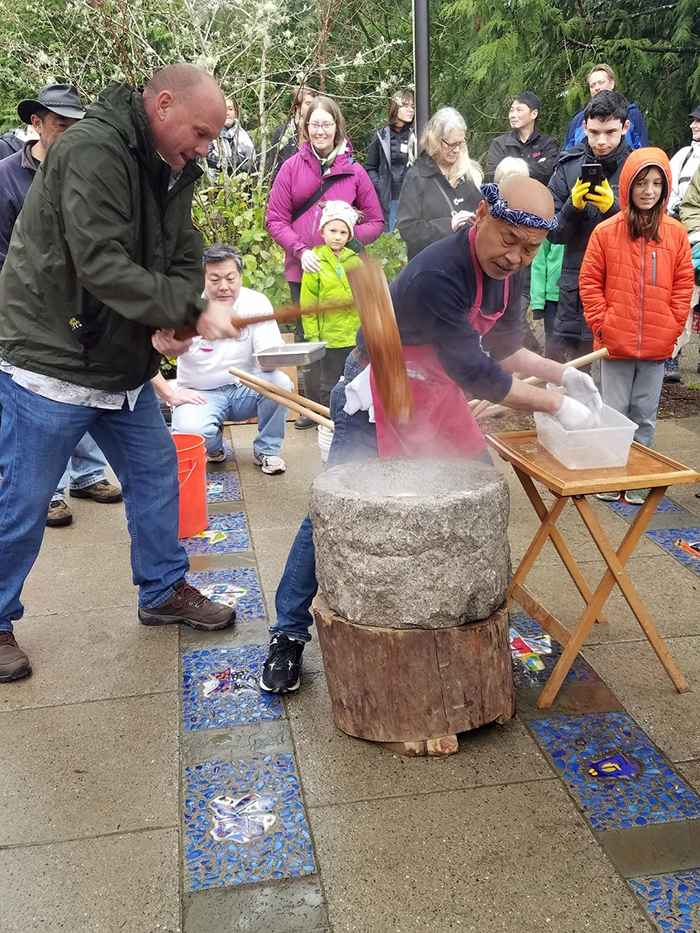By Jessica Kai Curry
NORTHWEST ASIAN WEEKLY

Shoichi Sugiyama teaches Bill Wilson from Renton how to make mochi the old-fashioned way. (Photo by J Kai Curry/NWAW)
What started as a private celebration between friends and family on Bainbridge Island has grown into a widely-anticipated public festival that attracted over 1,000 participants this year.
The highlight of the Jan. 7 event marking the 29th annual Mochi Tsuki was unquestionably the mochi making demonstration, led by the charismatic Shoichi Sugiyama.
Traditional mochi making is a kinetic combination of muscle power, rhythm, and dedication. The rice is first steamed in traditional wooden boxes, then put into a granite vessel, or “usu,” where it is pounded with mallets called “kine” until it is of the proper consistency. Once the rice is turned into a sticky paste, it is shaped around a sweet, bean paste center.
Guests at the festival were invited to participate in the pounding process, and to make their own mochi afterwards. Sharing the mochi, explained Clarence Moriwaki, Bainbridge Island Japanese American Community (BIJAC) president, becomes part of the participants’ New Year’s wishes for health and prosperity.
“The sweet rice brings people together, and they have fun making it,” he said.
The rice used to make mochi is not everyday rice — it is sweeter and, in olden times, it was more valuable. Therefore, making mochi turned into a precious New Year’s ritual, practiced in Japan for millennia. Though many people are familiar with the tasty treat, sometimes even guests from Japan have never had the opportunity to watch mochi made the traditional way.
“People always marvel,” Moriwaki said. “Even those up to 70 and 80 years old. When I ask them, ‘Where do you get your mochi?’ They respond, ‘In the store!’”
Guests from around the country, and the world, came to witness the event. The event started at 11 a.m., and by 10:50 a.m., the parking lot was full. Excitement and good cheer were in the air. In addition to mochi making, Mochi Tsuki 2018 featured origami making, and Japanese Taiko drumming — a BAJIC contribution to the ancient holiday ritual, this year performed by Seattle-based Kokon Taiko. Each portion of the festival featured a hands-on component for guests, who could learn origami, place good luck money into the mouth of a dragon during the Taiko performance, and of course, make their own mochi and take it home. As Moriwaki emphasized, “Getting the audience involved is a big part of the fun.”
The new year celebration is about looking forward, and back. It is about hoping for the best for the future, while never forgetting the past. It is about remembering who we are, for better or for worse, and about healing.
Two exhibits that focused on the Japanese American experience were also available. For the Sake of the Children, “Kodomo No Tame Ni,” a pictorial exhibit that was part of the 1989 Washington state bicentennial, could be viewed in the entrance of IslandWood; and the memorial, Let It Not Happen Again, “Nidoto Nai Yoni,” was within easy driving distance. The memorial is located at what was Eagledale ferry dock, where the first Japanese Americans in the United States were taken to internment camps in 1942.
In the IslandWood courtyard, under lightly falling rain, chief mochi maker Sugiyama called cadence and deftly turned the rice while volunteers pounded the rice. It was a rhythmic dance that mirrored the Taiko drumming taking place in IslandWood’s great hall.
Onlookers laughed at the exertions made by the volunteers, and at Sugiyama’s engaging repartee, all the while with mouths watering, waiting for that delicious mochi.
Akimashite Omedetto Gozaimasu! Happy New Year!
Jessica can be reached at info@nwasianweekly.com.


